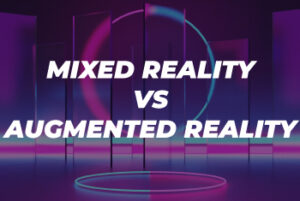

What is the purpose of virtual reality?
What is the purpose of virtual reality?
The immersive industry can be a minefield of confusing information
Virtual reality is quickly being adopted by almost every lucrative sector looking to future-proof and elevate their business offerings. The purpose of virtual reality varies from sector to sector. From using VR to aid learning and development in schools to creating an environment for medical professionals to develop their skillset ready for surgery, the possibilities of virtual reality are endless.
In this detailed blog, we highlight the different types of virtual reality and how immersive VR is being utilised globally by businesses and professions to improve communication and education. We want to answer the question “What is the purpose of virtual reality?”
What is virtual reality?
Virtual reality is defined as a digital experience, whereby the user interacts with a computer-generated visual 3D environment. Created with the latest tech, virtual reality offers access to a simulated world that can be tailored to replicate or completely different from the real world and the possibilities within it. For the best fully immersive virtual reality experience you’ll need a pair of VR glasses or a headset. However, there are variations of VR experiences that offer different levels of immersive realities for the user based on the technology and equipment used to create them. These variations can be categorised as:
- Non-immersive virtual reality
- Semi-immersive virtual reality
- Fully immersive reality
What are the different types of virtual reality?
Non-immersive virtual reality
Non-immersive virtual reality is a type of experience where the user interacts with a digital environment usually using a computer device. This type of VR experience allows you to interact with characters or elements of the environment, however, it is not immersive, meaning the environment is not able to interact with you.
An example of non-immersive virtual reality is traditional digital gameplay. This VR experience often requires a computer, keyboard, console or controller.
Semi-immersive virtual reality
Semi-immersive virtual reality allows the user to experience a hybrid of immersive reality whilst remaining fully aware of the real-world environment around them. The key to obtaining a great semi-immersive VR experience is to ensure that the 3D graphics within the gameplay are of high quality. This will help to improve the immersive experience for the end-user.
Examples of semi-immersive virtual reality are frequently seen in arcade gaming. These experiences often include multiple LED screens that offer the viewer multi-angle experiences of the digital environment. In order to fully benefit from the semi-immersive VR experience companies often invest in a physical element that the user can hold or sit in, such as a race car, to simulate and enhance the aim of the game.
Fully immersive virtual reality
Unlike semi-immersive virtual reality where the user remains attached and aware of real-world surroundings, a fully immersive VR experience detaches the user from the physical world. Through the use of VR equipment designed to enhance the virtual experience, such as headsets, gloves and bodysuits, users can visually and physically experience a completely digital environment that either enhances real-world experiences or specifically mimics them for the user to explore and interact with.
This level of immersion is obtained through specialised VR equipment and is used by many industries such as gaming, aerospace, military, medicine, healthcare and more.
What is the goal of virtual reality?
The goal of virtual reality technology is to create an immersive experience that can be used to explore an environment that helps to educate or entertain the end user.
As the tech industry continues to expand exponentially, businesses and consumers are constantly looking at how future tech can better power user experiences and improve training and resources.
What is the purpose of virtual reality in gameplay?
The gaming industry is one of the most lucrative and ever-expanding marketplaces. According to Forbes, the video game industry is growing at such a rate that it is believed that by 2025 it will be estimated at over $300 billion, with a marketplace of over 2.5 billion gamers worldwide.
With gamers constantly looking for the next thrill it is inevitable that virtual reality gaming is going to be the future. Virtual reality lifts gaming from an on-screen simulation to a powerfully immersive experience, detached from the physicalities of the real world. With the removal of keyboards and controllers, gamers can experience next-level sensory stimulation.
Virtual reality gaming can also help burn calories. Unlike non-immersive or traditional gaming where the user is confined to a static position to play, VR gaming allows the user to be physically active whilst experiencing their virtual environment. With the ability to walk around and work out using fully immersive technology, VR gaming can help to improve mobility from the comfort of your own home.
What is the purpose of virtual reality as an educational tool?
The benefits of virtual reality as a learning tool
Virtual reality used as an educational learning and development tool can far outweigh the traditional textbook style of learning. Being fully immersed in what you are learning can have a profound effect on the way that we retain information.
Imagine not just reading about architecture but being able to experience how a building is constructed or being able to walk around Ancient Egypt in a history class or taking a trip through space to see the planets up close. This style of learning can have a profound effect on how we retain information. According to Edgar Dale’s Cone of Learning, we are only 10% likely to remember something that we have read in comparison to being 90% more likely to remember something that we have experienced.
The benefits of virtual reality for specialised learning
As individuals, we learn at our own pace and our methods for retaining information will undoubtedly vary. For those with special learning needs traditional learning can sometimes feel overwhelming and result in cognitive overload. To help improve the way in which information can be delivered and more importantly retained, the educational sector has looked to future tech such as virtual reality to help improve their ability to communicate and deliver learning styles that can be tailored to individual needs for the best learning practices.
There are many great examples of how the education sector is using such VR experiences to optimise learning and improve comfort. Near-sighted virtual reality software is a great example of how users can learn more effectively and efficiently by controlling their environment to better develop their skills.
Such technology enables the user to experience a virtual classroom whilst adding text to the audio commentary, controlling text sizes, tailoring lighting and colour contrast levels for improved wellbeing and even interacting with others using sign language using VR gloves alongside a headset.
The benefits of virtual university and college tours
As many students look to complete their learning from universities around the globe it is not always possible or cost-effective for an individual to visit each destination in the physical sense. So, what is the purpose of virtual reality for learning? A virtual tour of the campus however offers a great solution to explore the facilities available and gather a feel for the grounds and classrooms. Columbia University’s virtual reality experience is a great example of how prospective students are able to move around the campus and explore classroom offerings.
With virtual reality able to simulate real-life experiences and create a powerful emotive feeling through an interactive environment The University of Michigan has leveraged VR technology to simulate for prospective football students what it feels like to be a football player at the university. By placing the user of their software in the centre of the university’s football pitch, they are able to navigate the full arena and experience the high of hearing energetic supporters in the stands.
How is VR being used in training for specialised roles?
There are many careers that require specialised training and skills in order to perform the most intricate or complex accuracy for success. Roles such as Surgeons or military defence often require training that could put people’s lives in danger if not completed correctly. There is no wonder that professions such as these have quickly turned to the use of virtual reality simulation technology to better develop skill sets and remove the possibility of a real-life negative outcome.
Another great purpose of virtual reality being used in such sectors is the opportunity it gives people to attend seminars and assessments from around the world. Travel is often a huge expense for companies and organisations and requires commitment and schedules to be adhered to which can often cause big delays in activities being carried out. Using VR headsets users can interact with lecturers, other students or teams and even complete tasks and exams through a learning environment using 3D immersive virtual reality software.
For example, staff at Voltswagan often needed to travel vast distances to complete training at their facilities. However, the introduction of virtual reality has meant that the organisation has been able to train staff more effectively by offering virtual classes that can be accessed at any time and anywhere with the use of handy VR headsets and VR gloves.
What are the advantages of virtual reality?
As detailed, the possibilities of virtual reality are endless. As the future of technology grows and more businesses and professions look to advance their offerings, virtual reality is not only a growing trend for business operations but will soon become a necessity for effective and efficient operations. The question “What is the purpose of virtual reality?” has limitless answers and we are only governed by our imagination.
Once in place, the utilisation of virtual reality can significantly improve business communication, team skills, and customer experience and deliver better ROI for tech-savvy businesses. With users of VR software able to communicate, interact and adapt to their environment from around the world, the advantages of using virtual reality far outweigh the traditional learning and entertainment facilities still available on the market today.

